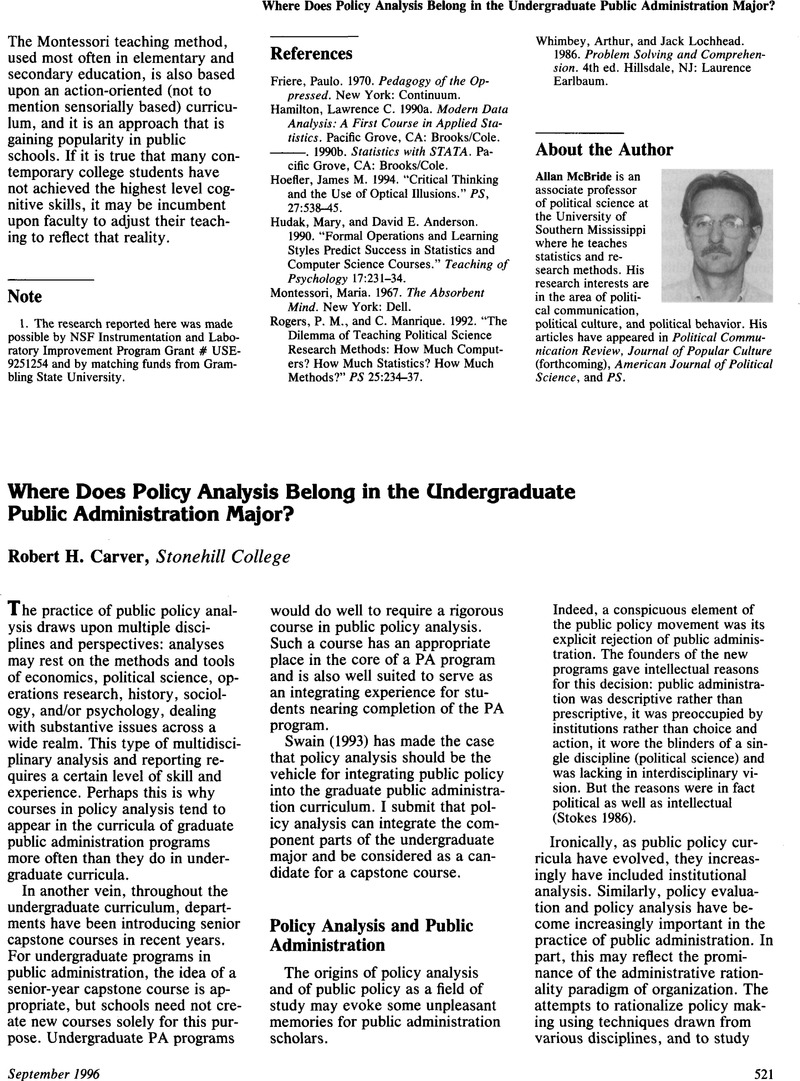No CrossRef data available.
Article contents
Where Does Policy Analysis Belong in the Undergraduate Public Administration Major?
Published online by Cambridge University Press: 02 September 2013
Abstract
An abstract is not available for this content so a preview has been provided. As you have access to this content, a full PDF is available via the ‘Save PDF’ action button.

- Type
- News
- Information
- Copyright
- Copyright © The American Political Science Association 1996
References
Association of American Colleges. 1985. Integrity in the College Curriculum: A Report to the Academic Community. Washington, DC: Association of American Colleges.Google Scholar
Averch, Harvey, and Dluhy, Milan. 1992. “Teaching Public Administration, Public Management and Policy Analysis: Convergence or Divergence in the Masters Core.” Journal of Policy Analysis and Management
11(3):541–51.CrossRefGoogle Scholar
Barzelay, Michael, and Kaboolian, Linda. 1990. “Structural Metaphors and Public Management Education.” Journal of Policy Analysis and Management, 9(4):599–610.CrossRefGoogle Scholar
Carlucci, Carl P.
1989. “The Role of Legislative Staff.” Journal of Management Science and Policy Analysis
7(1):21–33.Google Scholar
Cleary, Robert E.
1990. “What Do Public Administration Masters Programs Look Like? Do They Do What Is Needed?” Public Administration Review
50(6):663–73.CrossRefGoogle Scholar
Decker, Warren, and Lont, Cindy. 1990. “The Capstone Course in Speech Communication: Format and Purpose.” ACA Bulletin
72:51–59.Google Scholar
Elmore, Richard F.
1986. “Graduate Education in Public Management: Working the Seams of Government.” Journal of Policy Analysis and Management
6(1):69–83.CrossRefGoogle Scholar
Emmert, Mark A., Crow, Michael, and Shangraw, R. F. Jr., 1993. “Public Management in the Future: Post-Orthodoxy and Organization Design.” In Bozeman, Barry, ed. Public Management: The State of the Art. San Francisco: Jossey-Bass.Google Scholar
Friedman, Lee S.
1991. “Economists and Public Policy Programs.” Journal of Policy Analysis and Management
10(2):343–59.CrossRefGoogle Scholar
Hebert, F. Ted, Wright, Deil S., and Brudney, Jeffrey I.. 1992. “Challenges to State Governments: Policy and Administrative Leadership in the 1990's.” Public Productivity and Management Review, XVI, no. 1 (Fall), pp. 1–21.CrossRefGoogle Scholar
Heineman, Robert A., Bluhm, William T., Peterson, Steven A., and Kearny, Edward N.
1990. The World of the Policy Analyst: Rationality, Values, and Politics. Chatham NJ: Chatham House.Google Scholar
Jauch, Lawrence R., Snodgrass, Coral R., and Szewczak, Edward J.
1989. “Capstone Renaissance = Simulation + Interaction + DSS.” Simulation and Games
20(1):3–13.CrossRefGoogle Scholar
Kraemer, Kenneth L., and Northrup, Alana. 1989. “Curriculum Recommendations for Public Management Education in Computing: An Update.” Public Administration Review
49(5):447–53.CrossRefGoogle Scholar
Magner, Denise K.
1990. “Many Colleges Design Courses and Programs to Prepare Seniors to Live in the ‘Real World'.” Chronicle of Higher Education
36(27): A33, A35.Google Scholar
Mitchell, Jerry. 1991. “Education and Skills for Public Authority Management.” Public Administration Review.
51(5):429–37.CrossRefGoogle Scholar
National Association of Schools of Public Affairs and Administration. 1988. “Standards for Professional Masters Degree Programs in Public Affairs and Administration.” Washington: NASPAA.Google Scholar
O'Hare, Michael. 1991. “Formal Models and Government: Teaching to Do.” Journal of Policy Analysis and Management
10(3):519–41.CrossRefGoogle Scholar
Ott, J. Steven, Hyde, Albert C., and Shafritz, Jay M., eds. 1991. Public Management: The Essential Readings. Chicago: Nelson Hall.Google Scholar
Peterson's Guide to Four-Year Colleges. 1993. 23rd ed. Princeton NJ: Peterson's Guides.Google Scholar
Roeder, Phillip W., and Whitaker, Gordon. 1993. “Education for the Public Service: Policy Analysis and Administration in the M.P.A. Core Curriculum.” Administration and Society
24(4):512–40.CrossRefGoogle Scholar
Siegfried, John J., Bartlett, Robin L., Hansen, W. Lee, Kelley, Allen C., McCloskey, Donald N., and Tietenberg, Thomas H.
1991. “The Status and Prospects of the Economics Major.” Journal of Economic Education
22(3): 197–224.CrossRefGoogle Scholar
Stokes, Donald E.
1986. “Political and Organizational Analysis in the Policy Curriculum.” Journal of Policy Analysis and Management
6(1):45–55.CrossRefGoogle Scholar
Swain, John W.
1993. “Public Administration and Policy Analysis: Beyond Political Science.” International Journal of Public Administration
16(8): 1153–1175.CrossRefGoogle Scholar
Wallace, Richard Cheever. 1988. “A Capstone Course in Applied Sociology.” Teaching Sociology
16(1):34–40.CrossRefGoogle Scholar
Weiss, Carol. 1989. “Congressional Committees as Users of Analysis.” Journal of Policy Analysis and Management (8)3: 411–31.CrossRefGoogle Scholar
Wildavsky, Aaron. 1979. Speaking Truth to Power: The Art and Craft of Policy Analysis. Boston: Little, Brown.Google Scholar
Williams, David G., Stephenson, Max O. Jr., and Webber, David J.
1991. “Teaching the Missing Pieces of Policy Analysis.” PS: Political Science Politics (24)2: 218–20.Google Scholar




